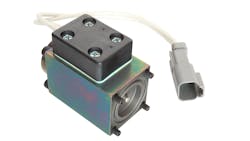Solenoids are an important device which help convert electrical energy into mechanical work. Understanding how to identify and fix potential issues which may arise with a solenoid helps to ensure proper repairs are made and larger machine issues can be prevented.
The following solenoid troubleshooting checklist outlines some of the key failures which can occur with solenoids and how to address them.
Issue 1: Overheating
When a solenoid is first energized, its coil receives a pulse of high inrush current that decreases as the plunger closes. If the plunger does not close, the high inrush current continues, which can cause the coil to overheat and burn out. This is the most common cause of solenoid failure and spotting it is easy.
When a coil burns out, the nylon bobbin upon which it is wound melts and runs into the air gap under the plunger. If you find melted bobbin material, see if the plunger was mechanically blocked open. On a double-solenoid valve, see if both solenoids were energized at the same time. (Magnet wire insulation wire may burn too).
Standard coils are rated class 105°C (221°F), so they can safely reach and sustain temperatures slightly hotter than boiling water. Thus, a solenoid too hot to touch may not be overheated.
A drop in supply line voltage can prevent a solenoid from closing by reducing its force until it can’t overcome the load’s resistance. Check the line voltage over a 24-hour period.
If ambient temperature is too high, the coil’s ability to dissipate heat by radiation is reduced. An overheated coil’s resistance increases, current flow and force are reduced, and the solenoid will not close, resulting in coil burnout again.
Check the cycling rate. If a solenoid cycles too fast, heat will build up faster than it can be dissipated. The solenoid becomes too weak to close, so it receives a continuous high inrush current and burns out.
READ MORE: Why Solenoid Coils on Hydraulic Valves Burn-Out
Issue 2: High Voltages
In rare cases, a solenoid coil will burn out due to over voltage. The plunger closes easily because the solenoid has extra force, but high voltage causes excessive holding current, which overheats the coil gradually and burns insulation on the magnet wire. There is no melted bobbin in this case.
Issue 3: Shorting
Another possible cause of solenoid coil burnout is shorting. Water-based coolants often carry fine metallic particles. Accidental splashing or soaking of the coil’s lead wire junctions can cause short circuits.
Issue 4: Damage
Finally, a solenoid can hammer itself to pieces — evidenced by mechanical damage and breakage. Excessive force can be caused by overvoltage or by a reduced load on the solenoid and must be absorbed when the plunger hits the C-stack or field.
Determine the cause of damage before replacing a solenoid. Its force should closely match the load.
This material was extracted from “What is a Solenoid?”, a free brochure previously available from ROSS Decco (formerly known as Detroit Coil Co. [Decco]).
About the Author

Leaders relevant to this article:
